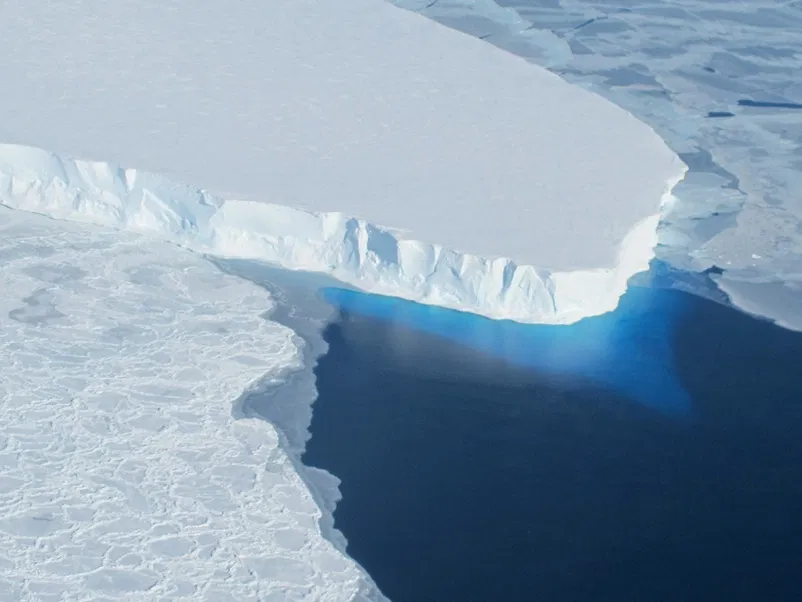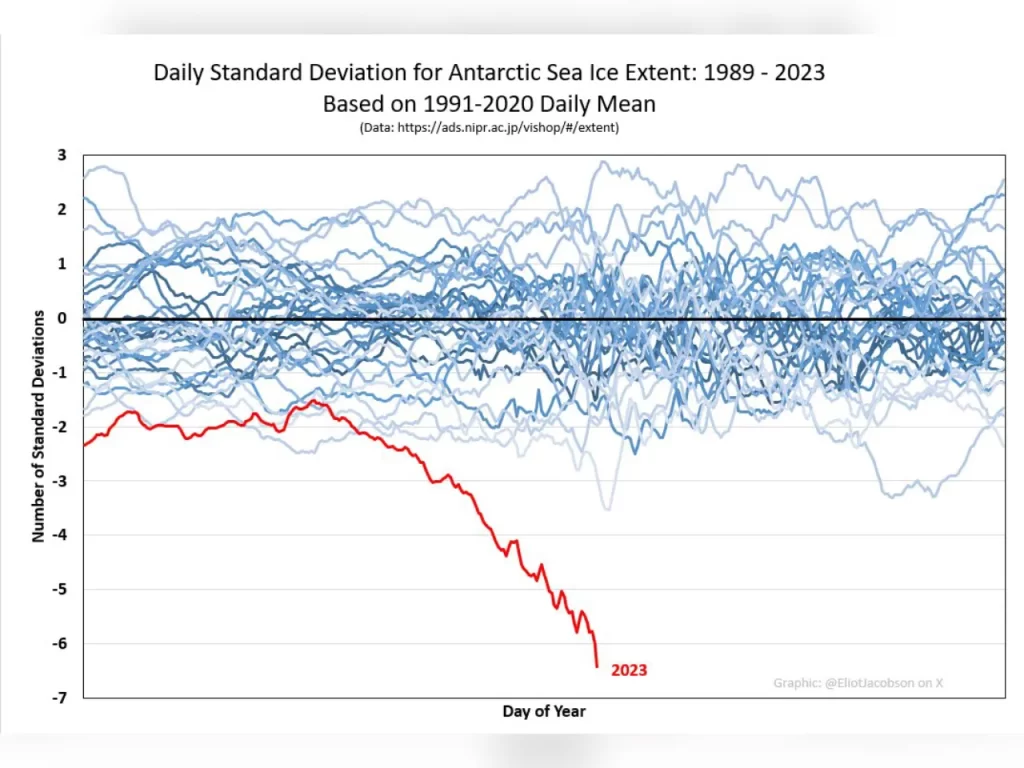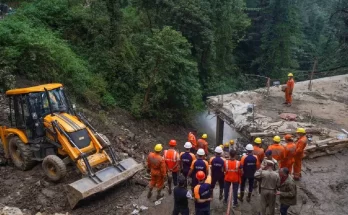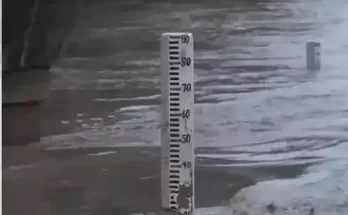Antarctica sea ice lowest since observations began.

Image used for representational purpose only. (Image Credit: NASA).
New Delhi: Two major weather events have shaken the scientific world this week — the headline-grabbing news about massive heatwaves engulfing North America, Europe, and China, and a lesser talked about but equally important event of an unprecedented, sharp decline in Antarctic sea ice.
Scientists have established a clear connection stating that North America and Europe heatwaves are virtually impossible without climate change and that China’s heat is at least 50 times more likely because of climate change. For Antarctica, it is too early to attribute the change to global warming.
Antarctica is surrounded by oceans from all sides. The surface of these oceans freezes over in winter and melts back each summer. The Antarctic sea ice reaches its peak generally in mid- to late September, but this year, it has been at a record low for the past few weeks.
A news report by the Australian Broadcasting Corporation website quoted physical oceanographer Edward Doddridge saying that vast regions of the Antarctic coastline are ice-free for the first time in the observational records.
“To say unprecedented isn’t strong enough,” Dr Doddridge was quoted. Adding a statistical term, he said, “This is a five-sigma event. So, it’s five standard deviations beyond the means. Which means, if nothing had changed, we’d expect to see a winter like this about once every 7.5 million years.”

Antarctica Sea Ice Extent 1989-2023
Eliot Jacobson, a retired professor of mathematics and computer science from the USA and a regular writer about climate disasters, late on Monday evening shared a graph on his Twitter handle with an explanation: “…here are the daily standard deviations for Antarctic Sea Ice extent for every day, 1989-2023 based on 1991-2020 mean. Each blue line represents the standard deviations for a full year. Lighter is more recent. 2023 is in red.” His tweet evoked widespread reactions.
However, a prominent Indian scientist has offered a word of caution. Dr Ranjan R Kelkar, former Director General, India Meteorological Department (IMD), said, “Daily mean should be considered with extreme care and presented with sufficient data along with the means. Climate is a long-term process. One should not reduce it to a daily mean. The atmospheric processes in one day are different from processes over the long term.”
Heatwaves and climate change
The last few days have seen unprecedented heatwaves in parts of the US, Mexico, and southern Europe. Even China has experienced severe heatwaves with temperatures above 45 degrees Celsius, leading to heat-related hospital admissions and deaths. In fact, heatwaves have caused wildfires in many places, such as Palermo after temperatures in the Italian city touched 47 degrees Celsius.
“The July heatwaves in Europe and North America would have been almost impossible without climate change,” according to rapid attribution analysis by World Weather Attribution (WWA), but “they are no longer unusual events due to warming caused by burning fossil fuels and other human activities”. WWA attributed these heatwaves to the effects of burning coal, oil and gas, deforestation, and other human activities. The analysis also found that climate change made the heatwave in China at least 50 times more likely.
Climate change has made heatwaves hotter, longer, and more frequent, a statement from the WWA said. To quantify the effect of climate change on the recent sustained high temperatures, scientists analysed weather data and computer model simulations to compare the climate as it is today, after about 1.2 degrees Celsius of global warming since the late 1800s, with the climate of the past, following peer-reviewed methods.
The analysis focused on the periods when the heat was most dangerous in each region: average maximum temperatures over seven days in southern Europe, over 18 days over the western US, Texas and northern Mexico, and over 14 days over the lowlands of China. The scientists found that heatwaves like these are no longer rare, due to warming caused by burning fossil fuels and other human activities.
Events like these can now be expected approximately once every 15 years in North America, about once every 10 years in southern Europe, and approximately once every five years in China.
Heatwaves like these will become even more frequent and extreme if emissions are not rapidly halted and reduced to net zero, the scientists warned. One of them, Friederike Otto, Senior Lecturer in Climate Science at the Grantham Institute for Climate Change and the Environment, Imperial College, London, said, “The result of this attribution study is not surprising. The world hasn’t stopped burning fossil fuels, the climate continues to warm, and heatwaves continue to become more extreme. It is that simple.”
“However, these heatwaves are not evidence of ‘runaway warming’ or ‘climate collapse.’ We still have time to secure a safe and healthy future, but we urgently need to stop burning fossil fuels and invest in decreasing vulnerability. If we do not, tens of thousands of people will keep dying from heat-related causes each year,” he said.
Heatwave, Antarctic sea ice, and Indian weather
The current heatwave in large parts of the northern hemisphere, the recent massive marine heatwave, and now, the unprecedented decline in Antarctic sea ice. Is it all connected?
Dr Avinash Kumar, a scientist from the National Centre for Polar and Ocean Research (NCPOR), Goa, replied in the affirmative.
Quoting from multiple published research papers, he explained, “In recent studies, based on the coupled atmospheric models, it has been stated that Antarctic sea ice will significantly affect the climate extremes recorded over southern continents.”
“It has been identified that there is stronger heat flux which tends to weaken the poleward temperature differences at mid-high latitudes and thus affects the mid-latitude jet streams. These dynamic and thermodynamic atmospheric circulations, in turn, increase the chances of blocking events and favours the occurrence of recent heatwave events,” Kumar told News9 Plus.
Established science points to the butterfly effect and affirms how, ultimately, everything is connected if the world is considered a single unit. Therefore, any change happening anywhere in the world is likely to have some or other impact on India.
To a question about the kind of impact any development in Antarctica has for India, Dr M Ravichandra, Secretary, Ministry of Earth Sciences (MoES), said, “There is a tele-connection. Lesser Antarctic sea ice means the Southern Ocean is warming. In turn, it will feed the Indian Ocean warming.”
“Due to warming in the Southern Ocean, the Mascarene high, around 30 degrees S latitude, will experience a high pressure than normal and thereby reduce the pressure gradient between Indian land mass and Mascarene high. Hence, the Indian monsoon may be modulated due to less cross-equatorial winds. But we need to watch carefully in all aspects of ocean and atmospheric circulation for better understanding,” the MoES Secretary added.
(This story first appeared on news9live.com on Jul 26, 2023 and can be read here.)



